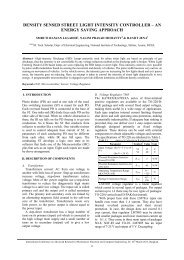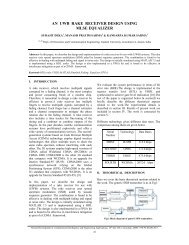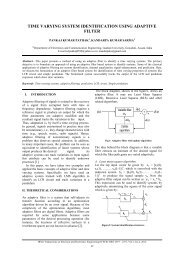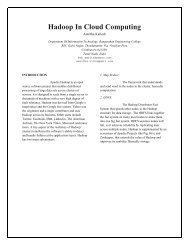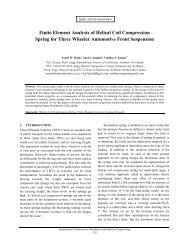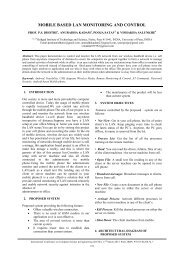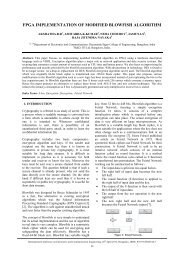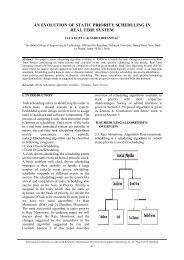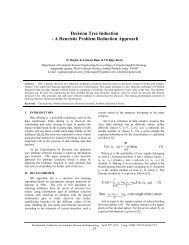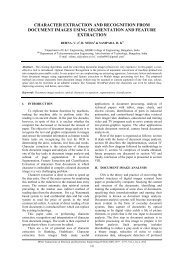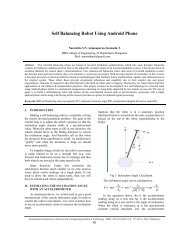Lossless and Lossy Image Compression Based on ... - IRNet Explore
Lossless and Lossy Image Compression Based on ... - IRNet Explore
Lossless and Lossy Image Compression Based on ... - IRNet Explore
You also want an ePaper? Increase the reach of your titles
YUMPU automatically turns print PDFs into web optimized ePapers that Google loves.
<str<strong>on</strong>g>Lossless</str<strong>on</strong>g> <str<strong>on</strong>g>and</str<strong>on</strong>g> <str<strong>on</strong>g>Lossy</str<strong>on</strong>g> <str<strong>on</strong>g>Image</str<strong>on</strong>g> <str<strong>on</strong>g>Compressi<strong>on</strong></str<strong>on</strong>g> <str<strong>on</strong>g>Based</str<strong>on</strong>g> On Data Folding<br />
mapping the data into a form that can be coded more<br />
efficiently by the last stage.<br />
The efficient image compressi<strong>on</strong> algorithm or any<br />
data compressi<strong>on</strong> is chosen according to scales, such as<br />
compressi<strong>on</strong> size, compressi<strong>on</strong> ratio, compressi<strong>on</strong><br />
efficiency <str<strong>on</strong>g>and</str<strong>on</strong>g> computati<strong>on</strong>al complexity. The proposed<br />
method works fast for compressing the images which<br />
gives image compressi<strong>on</strong> with good compressi<strong>on</strong><br />
efficiency <str<strong>on</strong>g>and</str<strong>on</strong>g> low computati<strong>on</strong>al complexity. The<br />
remainder of this paper is organized as follows:<br />
pixel redundancies are rearranged in a tile format <str<strong>on</strong>g>and</str<strong>on</strong>g><br />
Arithmetic encoding technique is applied which results<br />
the compressed image at the end before transmitting the<br />
data. The idea is to reduce the image size iteratively in<br />
terms of dimensi<strong>on</strong>s - rows or columns by 2. At the<br />
decoder, Arithmetic decoding is applied followed by data<br />
unfolding which is similar to data folding. Difference<br />
data thus obtained through all iterati<strong>on</strong>s is stored in the<br />
tile format, as shown in Fig. 1.<br />
Secti<strong>on</strong> II describes the c<strong>on</strong>cept of regi<strong>on</strong> of interest.<br />
Secti<strong>on</strong> III describes the proposed method, Secti<strong>on</strong> IV<br />
experimental results, Secti<strong>on</strong> V c<strong>on</strong>clusi<strong>on</strong> <str<strong>on</strong>g>and</str<strong>on</strong>g> future<br />
scope followed by references.<br />
2. CONCEPT OF ROI<br />
A Regi<strong>on</strong> of Interest, often abbreviated ROI, is a<br />
selected subset of samples within a dataset identified for<br />
a particular purpose. The c<strong>on</strong>cept of an ROI is comm<strong>on</strong>ly<br />
used in medical imaging. Medical imaging has a great<br />
impact <strong>on</strong> medicine, especially in the fields of diagnosis<br />
<str<strong>on</strong>g>and</str<strong>on</strong>g> surgical planning [11]. However, imaging devices<br />
c<strong>on</strong>tinue to generate large amounts of data per patient,<br />
which require l<strong>on</strong>g-term storage <str<strong>on</strong>g>and</str<strong>on</strong>g> efficient<br />
transmissi<strong>on</strong>. Current compressi<strong>on</strong> schemes produce high<br />
compressi<strong>on</strong> rates if loss of quality is affordable. An<br />
approach that brings a high compressi<strong>on</strong> rate with good<br />
quality in the ROI is thus necessary. The general theme is<br />
to preserve quality in diagnostically critical regi<strong>on</strong>s while<br />
allowing lossy encoding of the other regi<strong>on</strong>s For<br />
example; the boundaries of a tumour may be defined <strong>on</strong><br />
an image or in a volume, for the purpose of measuring its<br />
size. So in case of ROI we separate the regi<strong>on</strong> of interest<br />
from the complete image in which the user is interested.<br />
3. PROPOSED METHOD<br />
In the proposed method the compressi<strong>on</strong> idea is<br />
based <strong>on</strong> spatial resoluti<strong>on</strong> for lossless image<br />
compressi<strong>on</strong> called corrugati<strong>on</strong>/ data folding [6, 7, 8, 9,<br />
10]. The idea is to subtract even pixels from odd pixels<br />
<str<strong>on</strong>g>and</str<strong>on</strong>g> store the difference data in a buffer. Odd pixels are<br />
stored in another buffer for further iterati<strong>on</strong>s. In this<br />
<str<strong>on</strong>g>Image</str<strong>on</strong>g> compressi<strong>on</strong> method first column folding is<br />
applied followed by the row folding iteratively till the<br />
image size reduces to predefined value. In column<br />
folding, pixels used for subtracti<strong>on</strong> are column adjacent<br />
whereas in row folding, the pixels are row adjacent. The<br />
Fig. 1: Difference data arranged in the tile format<br />
3.1 Encoder<br />
3.1.1 Data Folding<br />
Data folding is an iterative procedure, column<br />
folding followed by row folding, that is repeated at every<br />
image level. Original image (i.e. input image) must be<br />
square.<br />
Define a buffer „F‟ (also called image matrix) whose<br />
size is equal to that of original image. Original image is<br />
c<strong>on</strong>sidered as input image for the first iterati<strong>on</strong>. Initially,<br />
the buffer „F‟ is empty. In column folding, odd columns<br />
of the input image are subtracted from its right adjacent<br />
even columns <str<strong>on</strong>g>and</str<strong>on</strong>g> stored in first half columns of the<br />
empty porti<strong>on</strong> of the buffer „F‟. Odd columns are stored<br />
in a different buffer S‟ which is taken as input image to<br />
row folding. Following equati<strong>on</strong>s depicts column folding<br />
technique [1].<br />
F( X+a, Y+b ) = S( a, 2b-1 ) – ( a, 2b)<br />
S‟( a, b ) = S( a, 2b-1)





